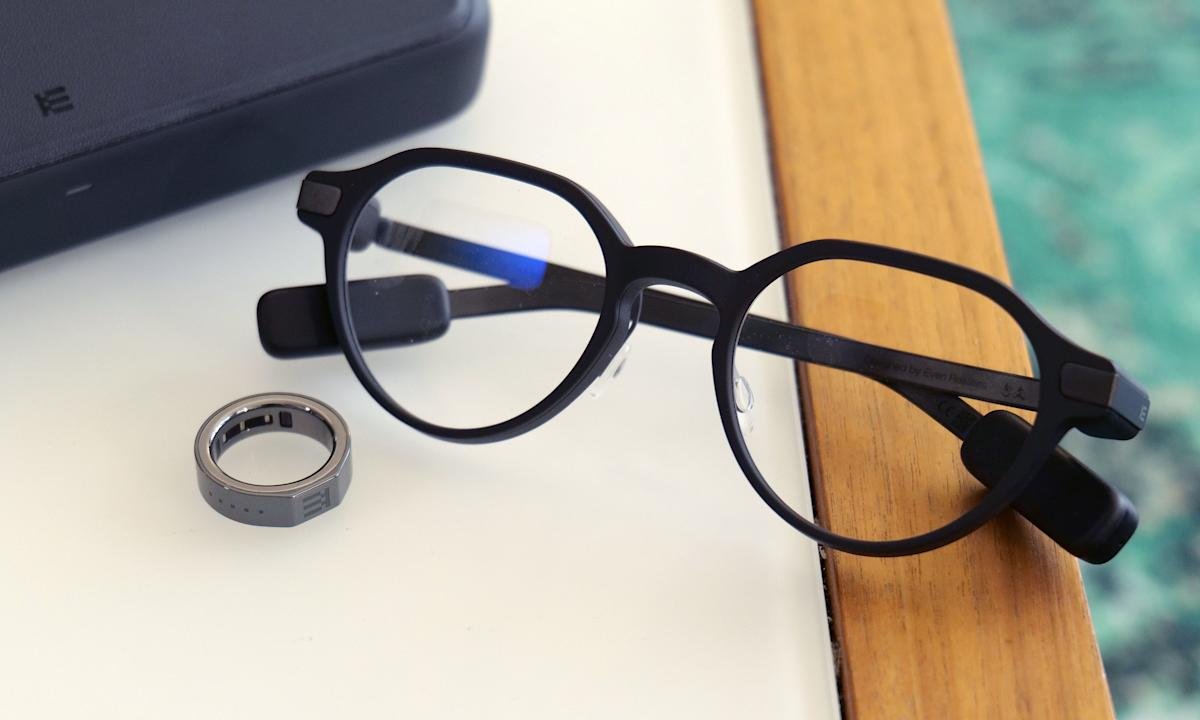Many people think that the original Google Glass failed due to poor technology. But the bigger issue was that they were so ugly that people didn’t want to wear them. And when it’s a device that sits on your face, that’s quite important. Thankfully, it’s a lesson that Even Realities also kept in mind when it created the G1, which combined the stylishness of proper eyewear with a built-in waveguide display. Now the company is back with its second generation smart glasses – the G2 – which offer even better optics, an updated UI, and a companion ring (R1) to their expanded features list.
Although the design of the Even G2 hasn’t changed one bit from its predecessor, that’s not a bad thing as there wasn’t much to improve upon. Compared to every other pair of smart glasses on sale today, these look just like normal glasses. Meanwhile, thanks to a titanium and magnesium alloy design and the company’s very deliberate decision not to include onboard cameras or speakers, the new models weigh just 36 grams, so they’re super comfortable too. You also get two styles (panto or rectangular) to choose from, along with a few different finishes (grey, brown and green), so chances are there’s a combination that will work with your wardrobe. The eOne G2 also has an IP67 rating for dust and water resistance, so you don’t have to worry about wearing these in adverse conditions.

The G2’s battery life can last up to two days, while its case supports up to seven additional charges. (Sam Rutherford for Engadget)
The G2’s optics are based on the company’s new Even HAO 2.0 (Holistic Adaptive Optics) that uses custom-designed dual waveguides to produce a green heads-up display. Not only is it brighter and clearer than ever, but it also has a wider field of view. Now admittedly, this isn’t as impressive as a single RGB display in something like the Ray-Ban Meta Display. But considering that the eOne G2 is less thick and has a significantly longer battery life (up to two days from its included case and seven full recharges), it seems like a worthy trade-off for providing increased usability.
However, the biggest upgrade to the G2 is the expanded roster of smart features. In addition to showing notifications, turn-by-turn directions, and the teleprompter functionality available on previous models, Even has developed a more robust UI that lets you read news, track stock prices, and create lists using your voice. There is now an onboard AI assistant and LLM that can instantly translate speech or pick out key words during a conversation to give more background and context about unfamiliar words. This means the glasses can handle many of the tasks you’d normally need your phone for, which is great if you’re moving around, or similarly uninitiated, and it’ll keep your hands free.

In addition to basic health and fitness tracking, the R1 Ring also has a small built-in touchpad (represented by four dots), making it easier to navigate the G2’s new UI and menus. (Sam Rutherford for Engadget)
While you can access most of these features using voice controls, the icing on the cake is the R1 companion ring that makes better use of the new UI. Not only does it track some basic health and fitness data (steps, heart rate, sleep, SpO2 and more), but it also works as a tiny touchpad so you can view notifications, revisit your notes, and more without anyone knowing what you’re doing. Overall, the G2 Glasses and the R1 Ring make for a very stylish and discreet package that allows you to stay connected and keep your phone in your pocket.
That said, you may want to wait before spending money on these. I’ve been testing the G2 and R1 for the past few days, and even though I really like the hardware, the company’s software isn’t ready yet. It’s important to note that I’m using the beta version of the Even Realties app, so encountering some bugs wasn’t completely unexpected. But still, the touch controls on the Ring feel imprecise and sometimes erratic. Many fitness metrics are not being recorded properly and both devices are having difficulty staying connected to the app. Even small things, like auto brightness settings (which don’t work at the moment) or the ability to add more sources to Glasses’ news feed, feel awkward. The only outlet I have been able to use successfully is ABC.

While the technology and features of the G2 are very interesting, I encountered several software issues while using the beta version of the app. (Sam Rutherford for Engadget)
Granted, some of the issues with the G2 and R1 that I encountered, like wonky touch input and incomplete health tracking, are known problems that are currently being worked on by Even Realities. Still, this feels like a situation where the launch of these devices should have been delayed until the company could clear these hurdles.
But if you’re unsure, the Even G2 Display Smart Glasses and Even R1 Smart Ring are on sale today for $599 and $249, respectively. For everyone else, I look forward to checking back on these devices once the company releases some software updates. I’m curious to see if they can ultimately live up to their potential as an interesting alternative to larger, heavier, and more intrusive smartglass options like the Ray-Ban Meta Display.
